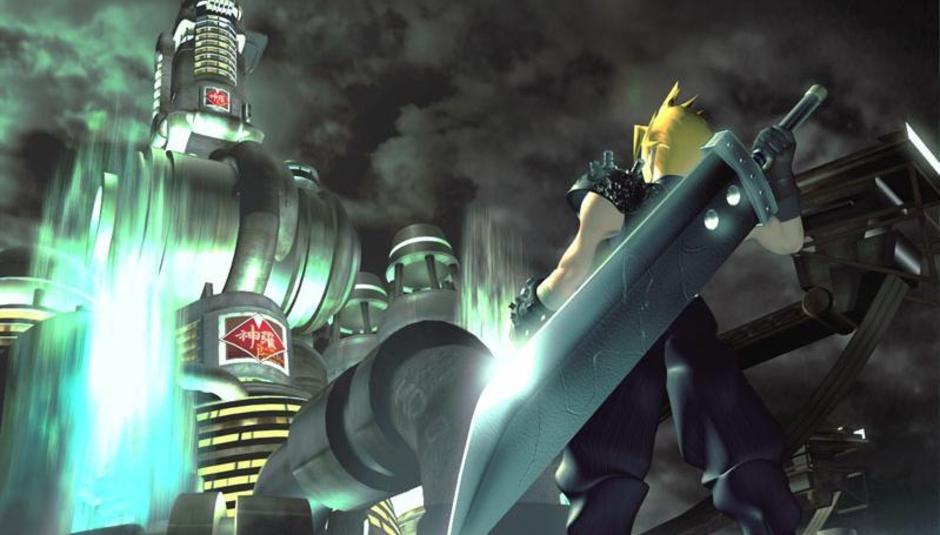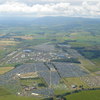Boiled down to its toughest leather, the RPG is simply a role-playing game. This is worth remembering when reading this column. Its focus is videogames, but the RPG world extends far beyond pixels and polygons. Indeed, RPG roots extend back to the 1970s, when tabletop Dungeons & Dragons sessions could take up a whole summer holiday.
Given the very broad church of the RPG, I’ve not been too strict on what can and can’t fall under the genre umbrella when selecting my ten essential titles – the first five of which follow this introduction. To me, these are quintessential examples of their kind – and utterly must-play for any person with a passing interest in electronic adventuring.
You will almost certainly have your own favourites, your own high watermark releases that warrant celebration. Please share them in the comments section, as Savage Pixels isn’t to be read as any sort of gospel. It’s just one gamer to some, shooting the virtual shit.
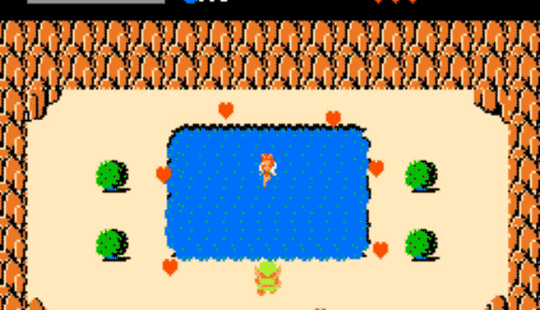
Ten Essential RPGs, Part One
The Legend of Zelda
Nintendo, 1987
Remarkable for a number of reasons, the first game in the still-running, multi-million-selling Zelda series did much to popularise the RPG in the western market. It was released for the Nintendo Entertainment System in the US and Europe a year after debuting in Japan, and became the first game cartridge to feature battery back-up – essential for a game that so easily ate up hours, and days, of the average gamer’s time.
The story is little to write home about, a fairly standard fantasy mix involving a kidnapped princess and a super-powered object (the Triforce) that can free her from her captor, regular series antagonist Ganon. That said, it’s a hugely satisfying adventure – and felt genuinely huge at the time. The hero, Link, would have to wait until the sequel to get his own name in the game’s title. But the little (dressed in) green man made a significant impression.
Combining simple controls and understandable upgrading with a challenging difficulty curve, and offering the freedom to wander the game-world and take on quests in the order the individual choose, Zelda was a (slightly unexpected) hit outside of Japan. It was the first NES game to shift a million copies, and the Zelda series has since shipped close to 70 million units.
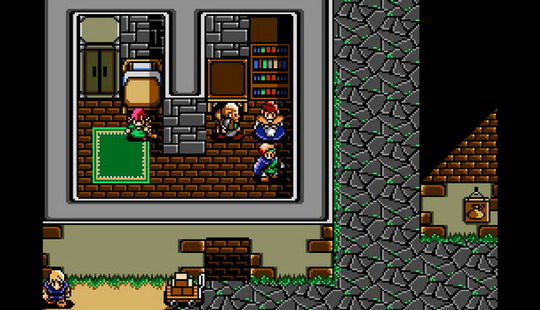
Shining Force
Sega, 1992
While Zelda’s action had an arcade-y feel, with both side-on and overhead sections played in the same sword-slashing style, Sega’s 1992 hit took a more tactical approach. Co-developed by Sonic! Software Planning – now Camelot, who recently released Mario Tennis Open for the 3DS – Shining Force was an adventure that required more thinking, less thrashing, or one’s progress could swiftly come to a standstill.
Set in a fantasy medieval-styled world not incomparable with that seen in Zelda (said land, Hyrule, is as much a character of the series as Link himself), Shining Force’s story concerns a hero, Max, who’s charged with stopping a right nasty sort, Dark Dragon, from being resurrected and tearing the land up. Inevitably, Dark Dragon’s three heads make a game-end appearance; but Max and his recruited party soon put an end to his designs on the fairly forgettable realm of Rune.
If the story’s not exactly unique, the gameplay seemed special back in 1992. It felt slicker than Sega’s own Phantasy Star II, which had been such a breakthrough title on the platform, and slightly more in tune with Square’s Super Famicom hit, Final Fantasy IV. While it took a methodical mind to conquer the game’s toughest enemies, Shining Force was never boring, with even simple-looking encounters likely to set the pulse racing.
With different character classes and a levelling-up process that’s easy to navigate, Shining Force featured RPG tropes that have become synonymous with the genre. Its multiple ports (including to iOS) mean that it’s easy to pick up today – and it’s well worth a weekend of your time.
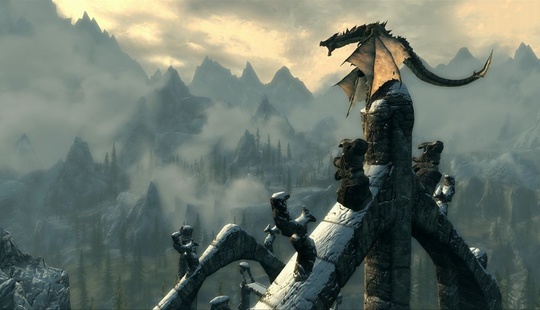
The Elder Scrolls V: Skyrim
Bethesda, 2011
Reviewed in the fifth Savage Pixels column, Bethesda’s latest instalment in the developer’s Elder Scrolls series is undoubtedly the greatest RPG of the last 12 months – if not the very best game, full stop, of that period.
Released for Windows, PlayStation 3 and Xbox 360, Skyrim is blessed by one of the most beautiful game-worlds ever shaped by long man-hours and expensive CPUs. To simply explore this vast virtual land, without paying actual quests any mind whatsoever, is a joy; get stuck in, and the game becomes one of the most addictive experiences on offer across contemporary platforms. Bethesda improved the close-quarter combat that felt lightweight in the preceding Oblivion chapter; and non-player characters gained more detailed facial animations, which helped cure their previous dead-eyed stiffness.
Levelling up – a key, nay core, RPG feature – happens quickly and easily, and although Skyrim’s skill trees (constellations?) aren’t the most obvious things for genre newcomers to get their heads around, it only takes a few hours for the game’s quirks to have become second-nature. Granted, the PS3 version was plagued by bugs (and the 360 one wasn’t without some gears-grinding moments of frustration), but not once in my experience did a ‘fault’ sour the overall impression left.
Which is that it’s a bona-fide classic of its kind, obviously.
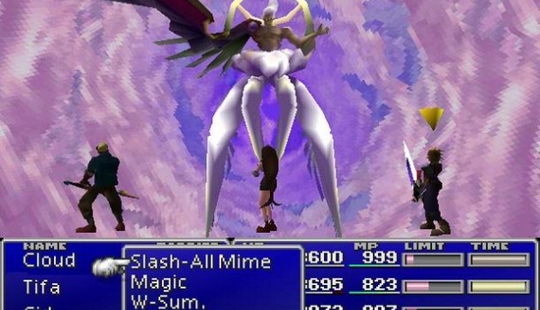
Final Fantasy VII
Square, 1997
Without Final Fantasy VII, RPGs would never have succeeded to the degree they have in the western market. It was – it is_ – huge, and (perhaps surprisingly) was the first _FF game to get an official UK release. It was also the first release of said series to switch to 3D polygons over side-on pixel pugilism. Sales figures stretch to 10 million copies, and it’s a mainstay on best-of lists compiled on any ‘side’ of the globe.
Combat was, as the series dictated, still turn-based. But with more in-game detail than ever before, and awesome-at-the-time CGI asides (“Over 120 minutes of mind-blowing cinematic sequences” boasts the packaging, over any actual gameplay pros), many a gamer left cold by earlier FF releases was soon converted. With a deep plot full of genuinely affecting moments, instant-click control, amazing locations – the industrial city of Midgar alone is worth the £20 or so this game goes for these days – and excellent music, FFVII is the complete RPG package.
Well, it was – there will be readers amongst you who’ll swear by FFVIII, or FFX, or even FFXII. They’re all good games – all great games, in fact. But none would have had the same impact in the UK, at least, without the breakthrough success of FFVII. So it doesn’t have voice acting, and the character models look like they’re made from Mega Bloks much of the time – none of the surface-level ‘shortcomings’ matter, as played today FFVII is every bit as engaging as it ever was.

Xenoblade Chronicles
Monolith Soft, 2010
While it’s since become both a critical and commercial success, Xenoblade Chronicles initially relied on word of mouth to sell it to curious RPG-ers. The work of Japanese company Monolith Soft, responsible for the Xenosaga series of RPGs on the PS2, Chronicles’ Nintendo Wii-exclusivity had been something of a handicap – that, and the fact that the game took over a year to earn itself an official EU release. But with Nintendo’s outgoing console available second-hand for the price of a couple of rounds, and Chronicles finally receiving an English localisation in 2011 (and a US release earlier this year), the game is now enjoying deserved recognition.
Chronicles is huge – said to be the size of Japan itself – and that’s a major part of its appeal, as the player can explore for days at a time, fully immersing themselves. Without too many pre-rendered cut-scenes to contrast against functional in-game graphics, a consistent aesthetic tone is maintained which very quickly sucks the player (and viewer(s), for that matter), into its world. The game’s battle system is innovative, with party members highlighted by an ‘aggro ring’ indicating just how vicious a certain enemy’s attack is likely to be.
Bonds can be formed between the player (rather poorly named Shulk, but you can’t have everything) and NPCs, firmed by undertaking side-quests. Unlike Mass Effect’s ‘loyalty’ missions, these have a greater effect on the game’s progress, as the player’s reputation from town to town is altered according to their reputation. Indeed, the feelings each character has for the others in Shulk’s party matters a great deal – turn a cold shoulder towards a party member, and expect them to be less-than-pleased with the situation. The music, by acclaimed composer Yoko Shimomura, is so good that it was packaged with the game in some territories.
Reviewers praised Chronicles as a J(apanese)RPG that breathed new life into the country’s gaming output, as western-developed series like The Elder Scrolls and Mass Effect threatened to gain an unbeatable grip on the RPG market. It’s probably, just probably, worth buying a Wii for. £30 for the game, £40-odd for the console: that’s better value for money than spending the same on a pair of 10-hour-long (if you’re lucky) first-person-shooters.
The Review Bit
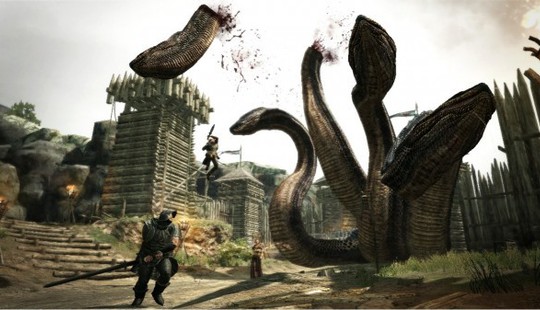
Dragon’s Dogma (pictured, above)
Capcom; Xbox 360, PlayStation 3
Game of Thrones
Cyanide; Xbox 360, PlayStation 3, Windows
Capcom and Cyanide are not developers that the mind immediately leaps to when it comes to RPG powerhouses. Typically, a contemporary RPG blessed by a cacophony of hype comes from the likes of Square Enix, BioWare, Bethesda Softworks or Blizzard Entertainment. But these unlikely houses are responsible for the highest-profile RPG games to have landed on consoles in recent weeks.
Cyanide, based in Paris, is a relatively small operation whose highest-profile release before the acquisition of the Game of Thrones license was probably Bloodbowl, a strange hybrid of sports simulation and turn-based fantasy combat. Capcom has an enviable history covering arcade beat-‘em-ups, pioneering survival horror adventures and sci-fi action platformers – but, the Monster Hunter and Breath of Fire franchises aside, it’s perhaps not a go-to brand for RPG gamers.
Both have succeeded with their latest products, though, albeit to very different extents based on expectations. With Capcom’s pedigree, Dragon’s Dogma was always likely to exhibit high production standards – but while it certainly delivers enough aesthetic delights and frenetic action, what’s surprising is how it surpasses initial impressions. With Hiroyuki Kobayashi and Hideaki Itsuno on the development team – the former the producer of Resident Evil 4 and (the utterly insane) Killer7; the latter involved with Devil May Cry 2, 3 and 4 – the end product positively sparkles given half a chance to bed in with the player. And once it hooks you, it’s hard to shake the game loose.
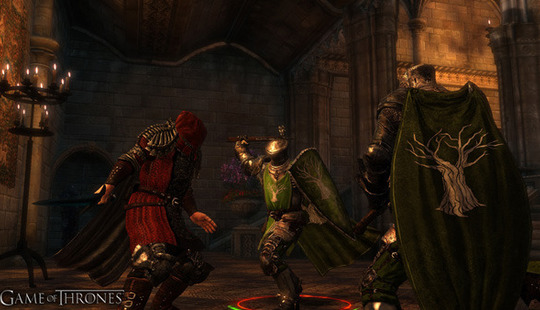
Game of Thrones: somewhere along the line, these capes are gonna get dirty - yet not once in the game does a washer-wench offer to rinse your garb
Dragon’s Dogma’s story is a fairly familiar one – a hero sets out to slay a big monster, wow – but it’s such a well-designed game that clichés, of which there are numerous, never spoil the experience. Exploration is a joy, and the whole world (called Gransys) is open to the player from the outset. Many aspects of the player’s character are modifiable – there’s your standard array of classes, builds and the like, though it lacks the differing species of the Elder Scrolls series – but the main quest remains the same: the ‘Arisen’ (that’s you) has to go kill a dragon, the same dragon that pops out your heart and eats it within the first few moments of gameplay. How you’re still moving about… um, yeah. It’s a game, just go with it.
The downside to having the whole world to explore immediately is that Dragon’s Dogma can seem incredibly difficult for its first five hours or so, as quests available early on prove too difficult for the player’s current level. Thankfully, one’s character becomes stronger quickly, and those pesky lizard-things down the well that were so tough to kill in hour two collapse like cardboard cut-outs come hour nine. Load-screen messages constantly remind the player that if an area’s too tough, just come back later – advice worth heeding, if you want your controller to remain in one piece.
While Capcom’s title encourages its player to seek out his or her own story, albeit within pre-determined parameters, Cyanide’s second Game of Thrones release following 2011’s strategy title Genesis is a mostly linear offering. The player assumes the roles of two characters not present in author George R R Martin’s A Song of Ice and Fire series of novels, grizzled Night’s Watch brother Mors Westford and Red Priest Alester Sarwyck. But neither man is free to wander the richly detailed world of Westeros conjured by Martin’s writing, and more recently in two series of the HBO television show.

Dragon's Dogma: enemies are many and varied, and believe me when I say any of them can killer a man, seriously
Instead, fast-travel shortcuts rob the player of journeying down the Kingsroad, tackling the marshes of the Neck or braving the deserts of Dorne. When the game moves from location to location, load screen cuts to small sandbox environments full of invisible walls, popping textures and terribly wooden NPCs, opportunities for exploration minimal.
One might expect to be impressed by the variety of lifestyles, of social classes, witnessed in King’s Landing, capital of Westeros – but the same boring walls line the streets throughout, the same hunched beggars moan and groan beneath identical cowls, and even the throne room itself lacks any standout grandeur. Chataya’s brothel doesn’t look any more comfortable to spend a night in than the dungeons of the Red Keep.
But graphical shortcomings, and the game’s awful voice acting, could be overlooked if there was a great game beneath everything. But Game of Thrones is far from a brilliant interactive take on Martin’s hugely popular fiction. Story wise it’s very strong, and Cynanide should be congratulated for successfully telling a tale that complements the events of the first …Ice and Fire novel, crisscrossing its key plotlines without ever altering how the book – and the TV show – pan out. Conspiracies abound, and treachery lurks around every look-alike corner. There’s enough meat in the narrative to keep the player coming back for more, and chaptered progression ensures that there are clear markers for the start and end of each session, should one wish to tackle the game that way.
Cyanide should be applauded, too, for trying a hybrid combat system of straightforward hack-and-slash – which Dragon’s Dogma favours, alongside the same projectile attacks (magic, arrows… magic arrows) that feature in Skyrim – with a kind of turn-based ‘special moves’ set-up. The player targets an enemy and sets about lopping their limbs off; as they’re doing so, an energy gauge fills (slowly), and power-wheel-summoned commands trigger an array of offensive or defensive moves. It’s a little like Shining Force, meets Breath of Fire, meets Mass Effect – the later series also featuring a pop-up power-wheel from where abilities can be accessed.
At times the system flows smoothly, usually when there are only one or two assailants. When the screen busies, though, targeting individual opponents becomes troublesome, and the sluggish refilling of the power required to unleash strong attacks is a drag. It can be refilled at pace a few times per battle – but this leaves the player vulnerable, and there’s no specified cool-down period for this rapid-fill function, making its usage more random than tactical.
Game of Thrones allows you to take control of more than one party member when in battle – and Mors’ crudely drawn dog can be possessed (the gruff-toned, war-scarred Night’s Watchman is a skin-changer), allowing for neck-tearing animations, the disarming of shields, and proving useful for stealth kills. Dragon’s Dogma keeps the player in command of just their self-designed avatar, but the Arisen can be joined by up to four ‘pawns’ (people, but not people, that look just like people). These NPCs, one of which is player-created and remains present throughout the journey, come in different classes, and balancing a party is essential to overcoming the toughest enemies. Brute strength alone will rarely win the day, and magic-users can not only offer offensive skills but also heal the party as the battles progress.
A neat trick in Dragon’s Dogma is the ability to climb on top of larger enemies, Shadow of the Colossus-style. If you want to bring a cyclops down in double-quick time, it’s this technique you’ll be wanting to employ – even if close-quarter combat with a hulking brute carries obvious health hazards. An early set-piece featuring a hydra necessitates clambering onto the multiple-headed beast and hacking away, with gruesome results. Far larger creatures lay ahead, and tactical dismemberment is key to overcoming them.
Both games feature the expected buffet of upgrades – in Dragon’s Dogma, equipment can be improved frequently, and the player’s strength grows quickly; in Game of Thrones, levelling up means the distributing of points to increase particular characteristics (luck, strength and so on), and there’s an interesting load-out arrangement at the game’s commencement where perks and handicaps are balanced. So, Mors can be a great fighter; but an old war injury slows his reactions. Alester might possess remarkable powers of healing; but if caught in the heat of battle his attentions may wander, and he’ll be more exposed to attack as a result.
It’s probably needless to say that compared to the lavish HBO show, Cyanide’s Game of Thrones looks like a rushed affair desperate for reflected recognition from its television namesake. But the game’s development began back in 2009, so there’s been time aplenty to make it a release that lives up to the expectations of fans enraptured with Martin’s fantasy world. It’s clunky, almost-last-generation visuals, drama-destroying dialogue and brave but flawed gameplay should paint it a complete failure.
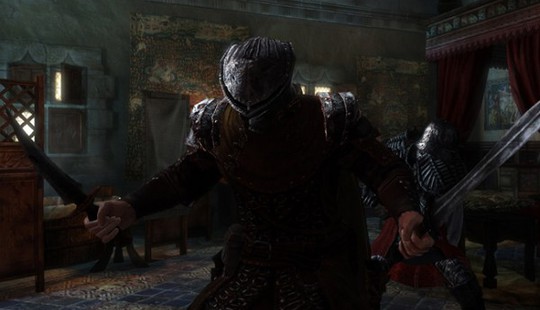
Game of Thrones: if all else fails, just remember to stick them with the pointy end
But such is the story’s appeal, and so admirable is the attempt to do something that bridges the divide between action- and strategy-based combat, that one comes away from Game of Thrones feeling… strangely satisfied. Persist with it, squinting through the faults, and it’s perversely quite enjoyable. It’s not as oddly captivating as something like Deadly Premonition or Two Worlds, but it comes away with a touch of the greyscale rather than suffering from the symptoms of the Pale Mare.
Dragon’s Dogma, meanwhile… well, ever since Skyrim’s release, every fantasy-set RPG has been billed as a potential successor to Bethesda’s masterpiece. This isn’t it – but it is an immersive, exciting game that will welcome action fans turned on by titles like Resi 4 and Devil May Cry just as easily as it should hardcore RPG-ers. It’s not always the prettiest-looking game, and it lacks any connection on an empathetic level; but get over the potentially off-putting difficulty and it becomes a lot of fun – like a simpler but no-less-appealing distant cousin of Dark Souls. It well and truly realigns the Capcom brand with quality output after the abject Operation Raccoon City back in March. Like that Resi entry wasn’t forgotten already.
Ten Essential RPGs, Part Two
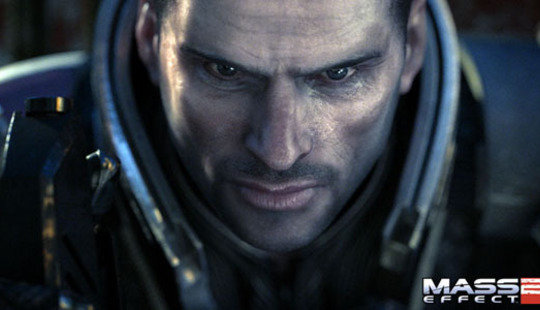
Mass Effect 2
BioWare, 2010
Why the second game over the first or third? I think it’s because of its tighter human focus. Although the third starts with the invasion of Earth, and its plot spins out from there, desperately trying to link a variety of quests to the need to save humankind from the Reaper menace, its universe-wide perspective can be dizzying. The second is less about planet-wide genocide, beginning with off-world colonies coming under attack, and as a result is rather easier to manage on the palate.
That’s not to say that there aren’t grander themes explored in game three (reviewed) – or that there’s anything wrong with the overall series plot-founding narrative of game one. But two, for me, perfects the interplay between action and emotion, intensity and moments of reflection, really quite masterfully.
The gameplay of the Mass Effect series changes little from game one to three. Gear is upgradeable, characters level up, and combat is usually undertaken from afar using a variety of rifles, pistols, grenades and so on. ME3 tweaks the melee mechanics for when things get up close and personal; ME1 allowed planetary exploration via the Mako personnel carrier, vehicle sections which didn’t make the following games for a very obvious reason (i.e. they were crap).
What does change is the quality of the storytelling, and although the climax of 3 is worth playing through two previous games for – unless you’re one of those who complained to BioWare, until they (sort of) bowed to pressure and released a free-to-download epilogue – there’s something about the against-all-odds ending to 2 that feels so much more… satisfying. Especially if one completes the ‘suicide mission’ against the Collectors with their entire squad intact.
Actually, thinking about it, perhaps 3 is better… Oh, I don’t know. Buy the lot.
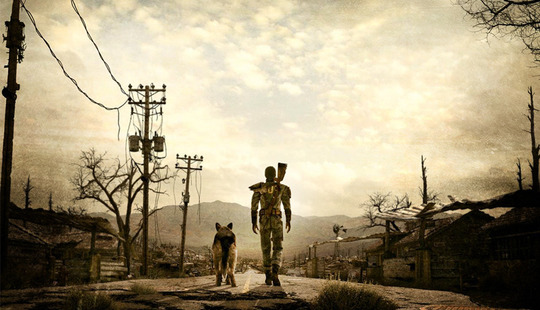
Fallout 3
Bethesda, 2008
One of the best realisations of a post-nuclear landscape in the gaming world – and goodness, there are a lot of them – Fallout 3 is a first-person RPG with real bite. Tough and gritty, it’s a compellingly bleak tale told through a host of struggling-along NPCs, horribly mutated creatures and gut-clenching moral choices, set amid the ruins of real-world landmarks like the White House and the Washington Monument.
The game begins unlike any other, with the actual birth of the player’s character in an underground shelter – a vault – which is one of many protecting mankind from the harsh environment outside. When the time comes to step outside, the whole world of Fallout 3 spills before you. It’s one of those moments in gaming, like crossing the border in Red Dead Redemption, or first setting foot inside the expanse of Hyrule in Ocarina of Time. The scale is monumental; as is the challenge facing the player is they want to complete this mammoth game.
To help, Bethesda incorporated some neat features. One of the most important is the Vault-Tec Assisted Targeting System (V.A.T.S.), which becomes so important in combat situations. Allowing the player to pause time and pick out specific areas of their opponent’s body to target, it introduces a strategic element to what might otherwise be plain old run-and-gun gameplay. The player’s own health is broken into areas, with attacks able to cripple limbs first before dealing any deathblow. It’s also vital to keep an eye on radiation levels. 200 years may have passed since the bombs fell (those that exploded, anyway), but the after-effects are a constant risk. The later-released Metro 2033 would also make item management to deal with this invisible drain of paramount progression importance.
It’s rare that visions of the future in videogames are beautiful – the bold but flawed Enslaved: Odyssey to the West might be an exception, although that’s just as characterised by a societal collapse – but Fallout 3 offsets its ugly, scarred terrains with beguiling storytelling full of secrets and strong antagonists. If the swords-and-sorcery of so many RPGs doesn’t do it for you, perhaps this oasis of hope in a desert of devastation will appeal.
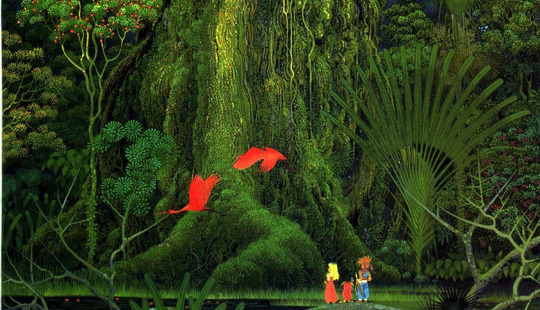
Secret of Mana
Square, 1993
This top-down wonder for the SNES, available today in a decent-enough iOS port, introduced a multi-player option to the usually lonesome RPG experience. Once the player ‘unlocks’ extra characters, they can call their best pal (and another mate, with the right peripheral) over to take control of either a mouthy girl or a cheeky sprite child, alongside the main hero, a large-haired sort with the name Randi.
But it wasn’t this feature alone that made Mana the hit it was, and the hugely influential title it’s remained since. A powerful but streamlined narrative made the game compelling enough that its dated graphical prowess is negligible today; fast-paced combat keeps players on their toes; and easy-to-navigate menus systems ensure that the right remedy is always on hand should the tide of battle turn against our protagonists.
Although anything from the 16-bit era is showing its age in 2012, it must be stressed that Mana was a beautiful game at the time. Making the most of the SNES’s Mode 7 graphics, it featured flying sections where locations could be accessed from the back of a friendly dragon. The music, too, was delightful – composed by Hiroki Kikuta, whose most-recent work can be heard in Soulcalibur V, it was made available for purchase in 93 and has since been played live by a full orchestra (one of several clips featuring such a performance can be seen below).
As great as Square’s achievements with Mana were, though, they’d soon follow the game up with something even more remarkable…
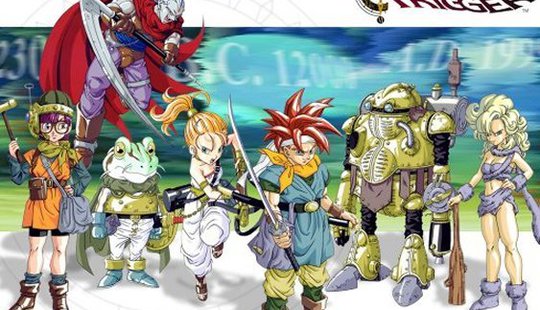
Chrono Trigger
Square, 1995
Although it was only available on import in the UK, Chrono Trigger was an instant hit Super Nintendo owners who’d fallen for Mana in a big way. With a similar graphical style and more of Square’s great music, which really pushed the capabilities of the system, it was obviously cut from the same quality of cloth. But Chrono Trigger was a deeper, tougher game that its predecessor.
The behind-the-scenes talent on Chrono Trigger was impressive indeed: Hironobu Sakaguchi founded the Final Fantasy series, Yugi Horii created the Dragon Quest games, and artist Akira Toriyama’s was responsible for one of the most famous mangas of all time, Dragon Ball. Soon enough the trio were dubbed the Dream Team by Square, and their efforts were rewarded with glowing reviews.
With multiple side-quests – hardly commonplace in RPGs at the time – time-travelling mechanics, and real substance to two-dimensional characters that made them feel more ‘alive’ than a lot of the beautiful 3D models found in today’s Final Fantasy games, Chrono Trigger was a work of fantastic design and sublime art. It shows its age with its plot – the apocalypse that shakes the game’s world occurs in 1999 (it’s far from alone – the events of the animated Transformers: The Movie take place in 2005, and shape-shifting cities still seem a way off yet) – but even though its 16-bit technology is dated, Chrono Trigger is gorgeous to look at throughout, and boasts superb gameplay.
Chrono Trigger spawned a sequel, Chrono Cross, which unlike the follow-up to Mana was made available in English-speaking territories. But despite its enhanced aesthetics and the superior hardware of its PlayStation platform, the game lacked the charm of Trigger. A perfect conversion of the SNES game is available today via the Wii’s Virtual Console; it’s also on iOS, albeit not without its faults on the mobile version.

Pokémon
Game Freak, 1996
No, it’s not just a kid’s game. Pokémon, in its Red and Blue Game Boy guises, is a tough-as-nails RPG experience.
Though perhaps not the very best RPG on Nintendo’s classic handheld – that accolade surely goes to The Legend of Zelda: Link’s Awakening (which I never actually finished, and must do sometime) – the depth of Pokémon goes beyond its monochromatic peers. The player assembles a cast of monsters for combat purposes, with a total of 151 critters available to collect. Each has its own special abilities – and it’s the careful management of this array of talents that produces success.
A global hit, Pokémon has been named the best-selling RPG of all time by IGN – and it’s not just the cutesy value of its lead characters that appeals, as evidenced by the games’ popularity with rather more discerning adult gamers. Accessible, but complex beasts to master, these games are blueprints of sorts: they laid foundations for RPGs to become true mainstream affairs, going beyond even Final Fantasy VII’s influence.
Basically, no Pokémon and today’s RPG scene would be very different indeed.
Preview: Ni No Kuni: Wrath of the White Witch
Enough words have been spilled on this column already – far too many, if I’m honest. Sorry about that. So I’ll leave you with footage… of what just might be the most beautiful RPG ever realised, a game co-developed by the acclaimed animation house Studio Ghibli. Ni No Kuni is released in the UK, for the PlayStation 3, in January (it’s already out in Japan). If there’s not a PS3 sat under your telly, you might want to pop out and get one…
Savage Pixels is taking a hiatus for a while, to recharge batteries and complete some of the slew of games it’s picked up since starting this column (those that didn’t need reviewing - there are LOADS here). In the meantime, please do suggest ‘specials’ to run in the future (shoot-‘em-ups? A potted history of Grand Theft Auto? Sonic vs Mario: The Glory Years?) via the comments section below. Or Tweet me. I am on Twitter. Here. Thanks…

